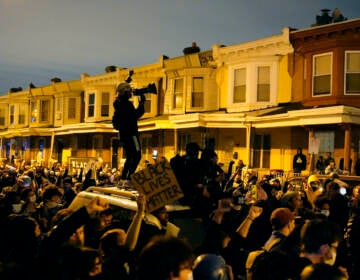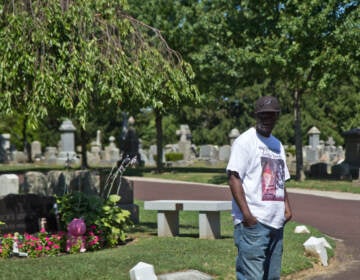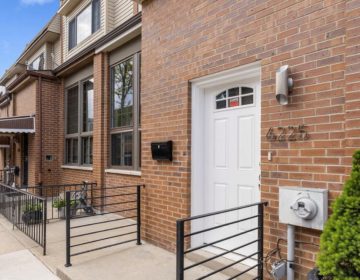‘Music’ of construction greets Osage Ave. neighbors on MOVE bombing anniversary
On the 34th anniversary of the MOVE bombing, 16 of the homes that were destroyed are newly rebuilt and residents have begun to move in.
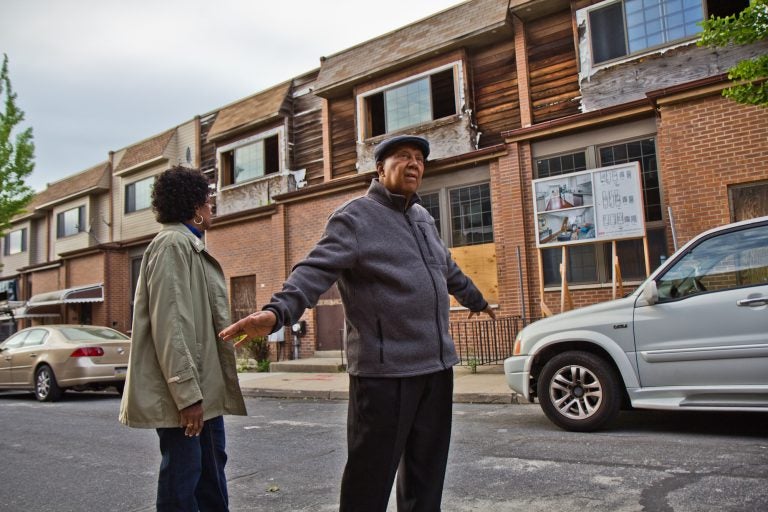
Gerald Renfrow and his wife Connie have stayed on the block despite many of their neighbors taking buyouts from the the city and are looking forward to more activity. (Kimberly Paynter/WHYY)
This article originally appeared on PlanPhilly.
—
Connie and Gerald Renfrow have lived on an exceptionally quiet block of Osage Avenue for nearly 20 years. With more than half of the houses surrounding them vacant and boarded up, there was no one around to make noise.
Lately, it’s gotten louder — and the West Philadelphia couple is thrilled.
“Every bang, every loud noise is like music to our ears, because we know the bangs and the bumps are coming in to restore our community,” said Gerald Renfrow. “The hammering, the nailing, the sawing, the dumpsters on the block, we just love every bit of it.”
Thirty-four years ago, Philadelphia police dropped a bomb on Osage Avenue, killing 11 members of the MOVE organization, including children, and destroying 61 homes.
The Renfrow family lived through it, losing the home Gerald grew up in to the deadly fire.
Now on the 34th anniversary of the bombing, 16 of the homes are freshly rebuilt and new neighbors are moving in. In March, the demolition teams made their way onto the Renfrow’s section of Osage near the intersection of Pine Street, bringing with them the clatter and debris of a construction site that spans more than half a block.
“My hope is that it will be, once again, a beautiful community,” said Gerald Renfrow. “And maybe once again we can be extended family. We’ll be getting to know our new neighbors, they’ll be getting to know us.”
But for decades, the Renfrows sacrificed to stay in their home, pushing back against the city many times and experiencing many broken promises. So much so that Gerald has come to believe that the city always wanted to give homeowners the boot and “gentrify this neighborhood.”
Now, he’s waiting to see what will happen. If the rehabs go well, and neighbors move in, he’ll finally invest in necessary repairs to his own home. But not yet.
“We’ve learned not to have total faith in any project that’s affiliated with the city,” he said. “These developers are affiliated with the city.”
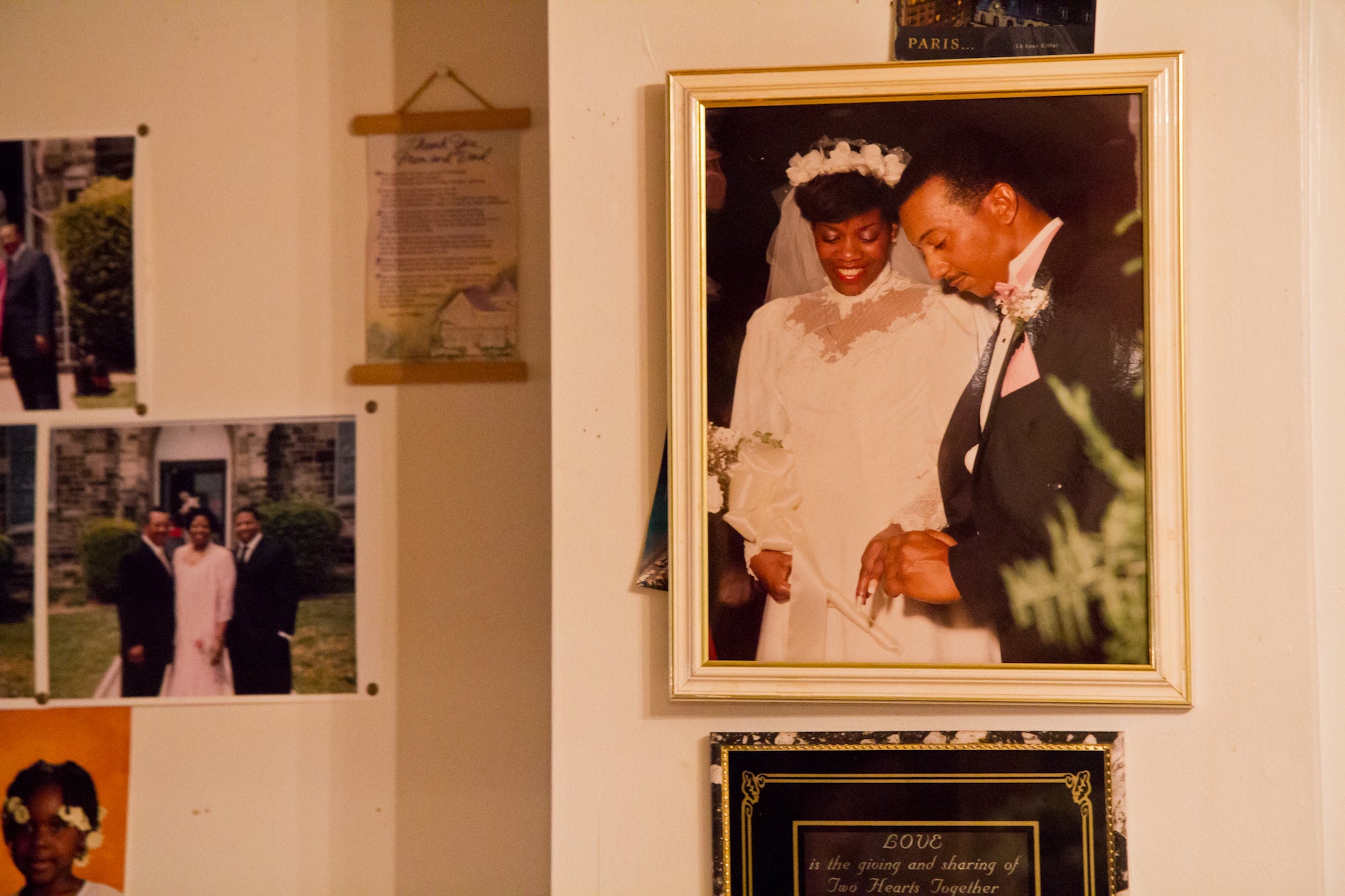
Surviving MOVE
Renfrow moved onto this block as a kid in 1959. When he and Connie, a childhood sweetheart, reconnected as adults, they eagerly purchased on Osage, rejoining a family of tight-knit neighbors, kids flitting stoop to stoop. It didn’t last long.
“We got married on April 27, so our honeymoon turned out to be the MOVE bombing,” Renfrow said.
After the bombing, the Philadelphia Redevelopment Authority hired a developer to replace the 61 homes destroyed when the city made a fateful decision to let the fire burn.
The new houses were completed in 1986, and the Renfrows moved back in. Where their old home had a stoop and a screened in porch, their new doorway is flush to the street. The ornate wood detailing from the old rowhomes is gone, replaced with the high ceilings, open floor plan, split-level design of more modern construction.
The Renfros liked the new house, but it quickly became clear the construction was shoddy.
“The first winter we had maybe 20-some-odd roof leaks,” said Gerald Renfrow. “Then it went downhill from there.”
The electrical wiring was faulty. The plumbing was bad. The ceilings drooped. In the early 2000s, the city offered to buy back the houses for $150,000. Nearly two-thirds of neighbors took the deal. But the Renfrows didn’t bite. So they ended up sandwiched between vacant houses for nearly two decades.
It made for a sort of ghost town, almost-familiar, but shot through with unease. They still lived just a few doors down from 6214 Osage Avenue, where Gerald’s parents had lived, but his actual childhood home is long gone — and long abandoned. The vacancies attracted crime, and violence.
“It was an ordeal for us to live here,” he said.
Mayor after mayor struggled with what to do with those 36 city-owned houses. Then, when Mayor Jim Kenney came into office in 2016, Renfrow and the other neighbors launched a media campaign to get his attention. Greg Heller, executive director of the Philadelphia Redevelopment Authority, said the houses at Osage and Pine were a priority from the start.
“Clearly it was holding back these blocks and this community, creating a blight on the community, and it was something we wanted to deal with right away,” Heller said.
The PRA consulted studies by the Army Corps of Engineers that suggested the houses were structurally sound, and just needed a gut rehab, not demolition. And looking at the surrounding housing market, Heller determined that the city wouldn’t need to invest any public money to fix them. He thought a developer could turn a profit rehabbing the homes and selling them at market value, with no public subsidy.
But when the city put it out to bid — with an unusual request that the developer is “respectful of the area’s challenged history and the trauma that adjacent residents may have experienced” — just two developers responded.
“Which showed us that even though we thought this was economically feasible, for one reason or another, the market did not feel the same way,” Heller said.
But developers AJR Endeavors LLC already had their eyes on these homes, even before the RFP, said managing partner Anthony Fullard. They got the contract. The city sold AJR the vacant houses for $1, and the developers secured financing for the rehab from private investors. Though the company usually does new construction, they got to work, stripping the houses down to floor joists and ceiling joists, removing all the sheetrock, the wiring, the HVAC, the plumbing.
Now, the interiors of the 16 completed homes look as shiny and new as any prefab construction in Northern Liberties. They’re spacious split-levels with all the amenities: central air, quartz countertops, backyard decks. Nineteen houses have already sold, with prices starting at $259,000 — considerably higher than the area median.
“Which tells us pretty strongly that the problem here was not the market at large,” Heller said. “It was the fact that there were 36 vacant publicly owned properties creating this blighting influence. In many ways, we were the problem here.”
Fullard said AJR wasn’t daunted by the history of the site, and so far, homebuyers haven’t been either. There’s no MOVE marker on Osage or Pine. When a memorial went up last year, neighbors insisted it go up on Cobbs Creek Parkway instead. Before the bombing, this was a middle-class African American community. Now, many of the buyers are young, black professionals, Fuller said.
“You’re dealing with a younger clientele. A lot of people don’t even know about the incident, especially if they’re coming from outside Philadelphia,” he said. “And the community group that’s there, they don’t want that history that is connected with the MOVE organization memorialized on the block. They want their lives back, they want their community back.”
Because of the scale of the project, the developers have to contribute 1% of the cost to a public art project. Artist Shelley Spector and journalist Yvonne Latty will make a short film about the community, and then install artworks on the block that reflect what they heard — like, a “No Parking” sign that says “Looking out for each other” instead. Neighbors were adamant they did not want anything on the block that reflected the bombing.
Now that the rehabs are underway, Gerald Renfrow said some neighbors who took the buyout and left over a decade ago have inquired about moving back, but it’s too late. They’d have to buy the houses at market rate.
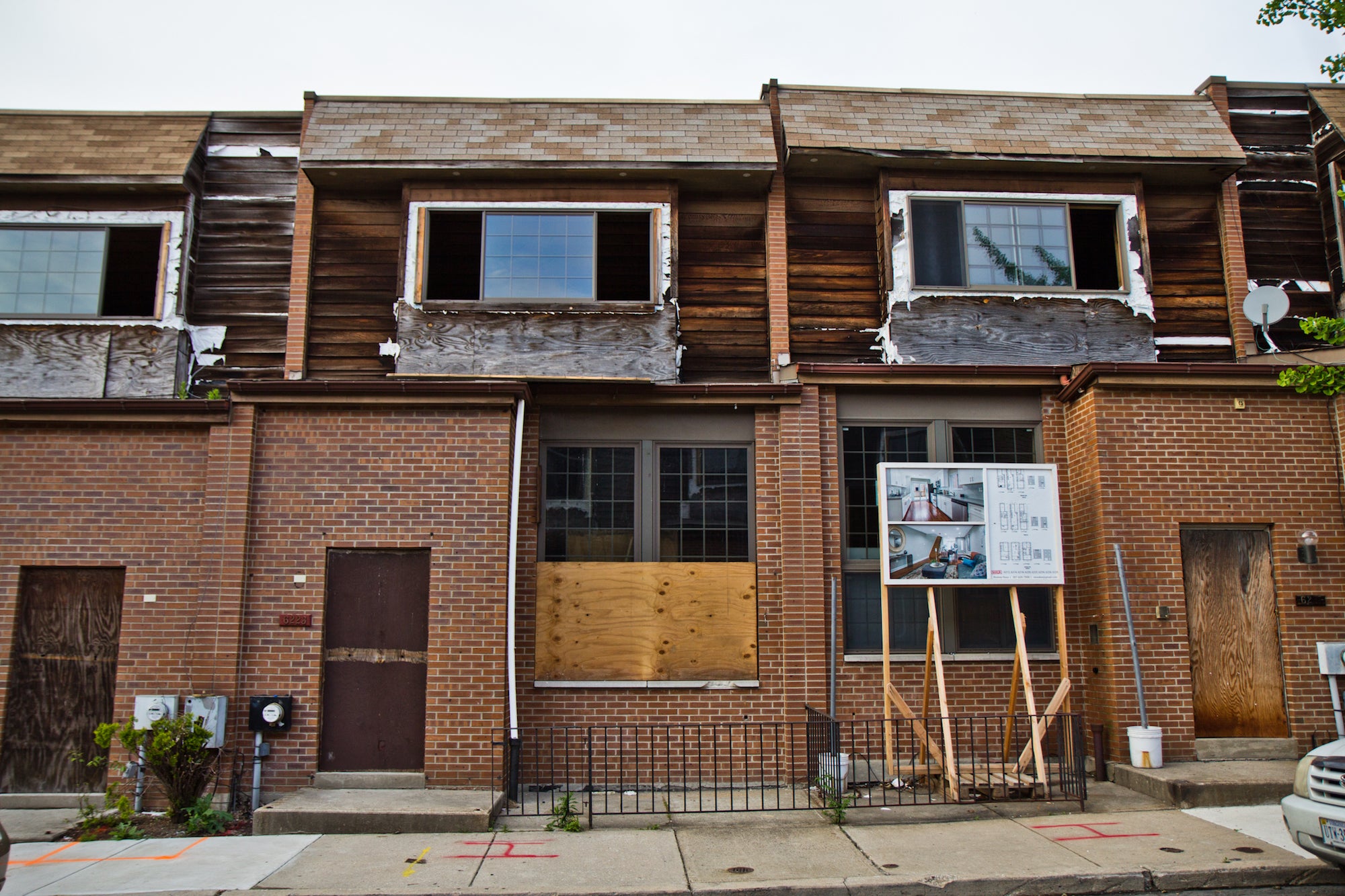
Rebuilding community
The neighbors who remained are tentatively hopeful. The developers met with them multiple times throughout the project to hear their concerns. Wary of this project gentrifying their block, they insisted that the homes be owner-occupied. The city agreed.
Pamela Buck, who has lived around the corner from 6200 Pine for 15 years, said she’s happy for the new neighbors.
“I think it’s very good, people moving in. Better to have people moving in than have a vacant lot on the block,” she said. “I did have a chance to look in one of [the houses]. Very nice, very nice. Expensive though.”
Buck is glad that her property values will go up because of the new construction, but she’s worried about rising property taxes.
Among other residents, especially those who have lived here since 1985, the bombing and then the shoddy construction have sowed deep distrust of city government. Askia Bayyat lives a block behind Pine Street. He remembers watching the bombing on TV and in person at the same time, and then watching as most of his neighbors moved away over the years. He said the rehabs are long overdue, but he’s skeptical.
“I’m just going to watch and see what happens. In about 5 or 10 years they might be falling down, you’ll never know,” he said.
The Renfrows are realists too, but they’re optimistic that soon the block they’ve loved most of their lives will finally feel like it used to — filled with families, tight-knit and with children around.
Walking down the street, surveying the still-boarded homes, and their well-tended one that looks like a sore thumb in between them, Connie Renfrow gets emotional. She pulls out a tissue and dots at her eyes.
“You just have to be patient. It’s in God’s time, not in our time. And when he gets ready, he moves. And it shows you because he moved on this when he got ready,” she said.
By the end of next year, the houses on Osage should be complete. The Renfrows hope this will be the last chapter of this story — at least, in their lifetime.
WHYY is your source for fact-based, in-depth journalism and information. As a nonprofit organization, we rely on financial support from readers like you. Please give today.




